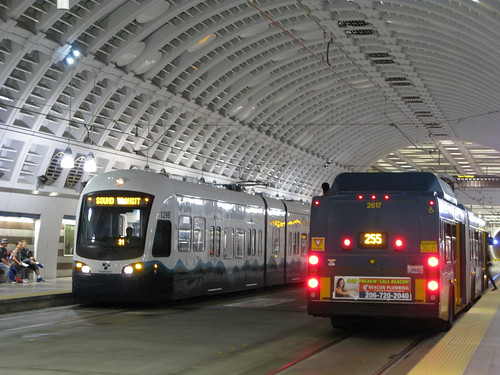
Dow Constantine is on fire. The King County Executive, first elected in 2009, made the headlines on Tuesday for vetoing Councilmember Rod Dembowski’s proposal to defer King County Metro’s impending service cuts. Now, Constantine has signed an executive order calling for Metro and Sound Transit to deeply integrate their operations and planning.
The executive order is surprisingly readable. But for those of you who don’t read legal documents for fun, here’s a high-level summary of what’s going on and why this matters for transit users.
Dow Constantine has a mission. Faced with a problem like Metro’s financial crisis, many executives would be happy to postpone cuts until after their reelection. Constantine is not one of them. Between his veto on Tuesday and this executive order, it’s becoming clear that Constantine is searching for a permanent solution—a comprehensive strategy that will break the vicious cycle of Metro crises once and for all. As the head of King County (of which Metro is a division) and the chair of Sound Transit’s Board of Directors, Constantine arguably has the most influence on transit policy of any politician in the Seattle area. Transit riders have a powerful ally.
The name of the game is “better.” In the press release accompanying his order, Constantine called on Metro and Sound Transit to improve and innovate:
Long term, our transportation future requires both adequate revenue and continuous innovation to expand service. This initiative advances the innovation half of that equation.
There are people who claim that Metro doesn’t need any more money and that all of their woes stem from mismanagement. There are other people who claim that more money will solve all of Metro’s problems. Constantine is taking a more pragmatic approach. Last month, he announced a program for cities to buy more bus service, while his latest proposal focuses on getting more value from the money we’re already spending. This multifaceted strategy is likely to produce better results than pursuing either angle without the other.
Metro’s reduction proposal may change significantly. Constantine explicitly calls on to Metro to “fully utilize the significantly greater operating speeds, reliability and capacity of RapidRide and Link light rail investments.” While this might sound like fluff, it’s actually a really big deal. Back when the Central Link light rail line was being planned, most observers assumed that Metro would modify buses like the 101 and 150, removing their freeway segments and sending them to light rail stations. Instead, Metro left these buses unchanged.
Constantine has given Metro an ultimatum to start rebuilding its network around Link, even if it means that Metro loses some ridership to Sound Transit. He has asked Sound Transit and Metro to publish an integration report by September. The report will discuss the upcoming service reductions as well as the opening of University Link in 2016. The report will be too late to affect the first phase of cuts, but we can assume that it will have a lot to say about the other three phases.
The future is bright. In his executive order, Constantine calls on Metro and Sound Transit to use the savings from bus/rail integration to improve bus service in places without rail stations, and to coordinate planning with the state highway department. These are common-sense reforms that the transit community has been requesting for years. But they are also acts of hope, not desperation. Constantine sees a future where Seattle has truly world-class transit. He’s not content to preserve Metro and Sound Transit’s current service level; he wants to make them much, much better. That’s a vision that we can get behind.
Aleksandra (Aleks) is a software engineer who moonlights as a writer and copy editor. Aleks's love of cities started as a child, when she would ride the commuter rail into Boston with her family for day trips. Her mission is to share that love with the world, by ensuring that our cities have a place for everyone. Aleks primarily writes about transportation and land use. She is also the webmaster.


